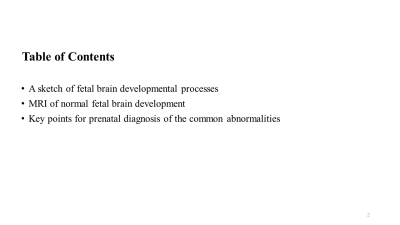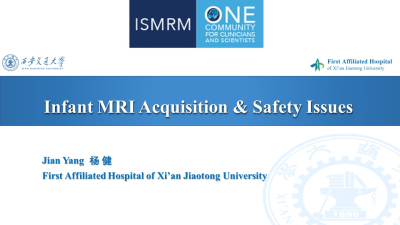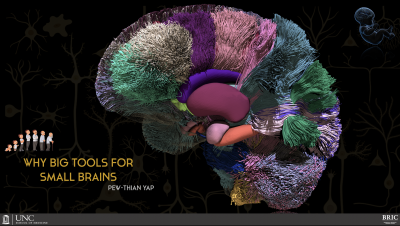Weekend Course
Advances in Perinatal MRI
ISMRM & ISMRT Annual Meeting & Exhibition • 04-09 May 2024 • Singapore

| Fetal MRI | |||
| 07:45 |
Fetal Brain Acquisition & Analysis
Joseph Hajnal
|
||
| 08:10 |
 |
Normal Fetal Brain Development & Prenatal Diseases
Guangbin Wang
Keywords: Cross-organ: Antenatal, Neuro: Brain, Education Committee: Clinical MRI The most rapid growth of the brain occurs in utero. MRI demonstrates the major developmental processes in utero, including the proliferation, migration, organization , gyration and myelination. Awareness of normal fetal brain development contributes to identify abnormalities. The key points for the MRI features of the common abnormalities promote accurate prenatal diagnosis. In our talk, we present the key signs of ventriculomegaly, callosal agenesis, microcephaly, schizencephaly, gray matter heterotopia, holoprosencephaly, intra/extra-cerebral hemorrhage and posterior fossa anomalies. |
|
| 08:35 |
Fetal-Placental Interactions
Yao Wu
|
||
| 09:00 |
Safety Issues in Fetal MRI
Teresa Victoria
|
||
| 09:25 |
Break & Meet the Teachers |
||
| Infant MRI | |||
| 09:55 |
 |
Infant MRI Acquisition & Safety Issues
Jian Yang, Xianjun Li, Chao Jin
Keywords: Cross-organ: Neonatal, Image acquisition: Motion correction, Cross-organ: Development Infant MRI is challenging due to their immaturity, small physical size, and motion artifact. A customized approach tailored to each baby's age and functional status with appropriate combination of dedicated procedure, imaging hardware and software is key. This presentation summarizes several technical and clinical approaches that can help to ensure safety and decrease the need for sedation in infants. These range from feeding and swaddling to specialized small bore scanners and coils, MRI compatible incubators, and noise-reduction methods. New pre- and post-processing techniques with artificial intelligence can also decrease both scan time and motion artifacts to enable a successful scan. |
|
| 10:20 |
 |
Why Big Tools for Small Brains
Pew-Thian Yap
Keywords: Neuro: Brain The infant brain is not a miniaturized adult brain and undergoes rapid and unique developmental processes. Using computational tools meant for adult MRI to analyze infant brains often leads to subpar results. This presentation discusses resources tailored specifically for analyzing infant MRI across various modalities, aiming to provide clearer insights into early human brain development. |
|
| 10:45 |
Normal & Abnormal Infant Brain Development
Yong He
Keywords: Neuro: Brain connectivity The structure and function human brain undergo rapid reorganization from birth to infancy, laying a critical foundation for the establishment of extensive cognitive and behavioral abilities later in life. I will present recent advances in typical and atypical brain development during infancy using multimodal neuroimaging techniques and connectome-based approaches. |
||
| 11:10 |
 |
Infant MRI Applications Beyond the Brain
Yun Peng
Keywords: Education Committee: Clinical MRI The applications of infant MRI have extended beyond the realm of brain imaging. This lecture will elaborate on the significance of MRI in infant imaging, elucidate the challenges inherent in such imaging endeavors. We address clinical inquir, andies concerning the fundamental concepts essential for acquiring optimal images and deepen the understanding of the distinctive and optimal workflows associated with infant MR imaging. Moreover, we endeavor to present a large number of clinical cases beyond brain imaging, serving to illustrate the extensive applicability of infant MR examination in clinical settings and foster a deeper comprehension of this topic. |
|
The International Society for Magnetic Resonance in Medicine is accredited by the Accreditation Council for Continuing Medical Education to provide continuing medical education for physicians.